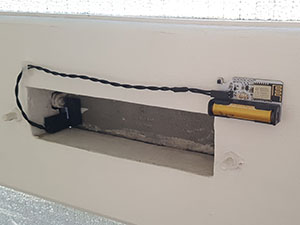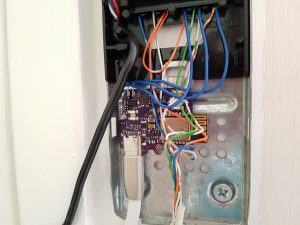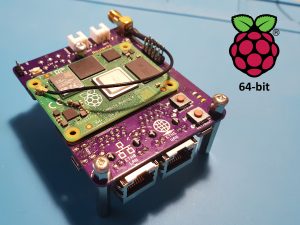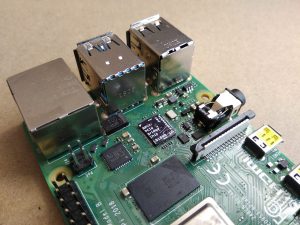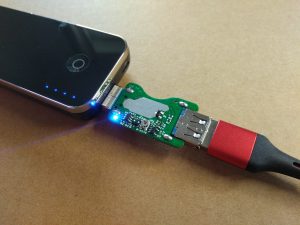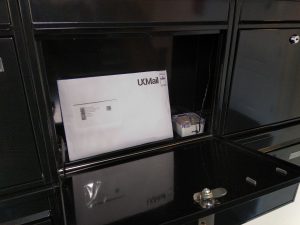It's probably about time that I figured out how to enable IPv6 on my RouterPi and network! At first, configuring dhcpcd was fairly straightforward and IPv6 connectivity worked almost right away. However, it later became intermittent after rebooting and checking that everything was still working. For some reason my ISP's (Hyperoptic) upstream router (not the one in my home) had decided to stop responding to Router Solicitation (RS) packets sent by my router.
-
-
Mail Notifier - WiFi Edition
After around 18 months of using my previous mail notifier the mobile network provider that I was using, ASDA, decided to move from EE's network to Vodafone's network. Unfortunately, the A9G GPRS module doesn't like the Vodafone network very much and I was unable to find another pay-as-you-go provider using EE's network that didn't have silly terms like requiring a £10 top-up every few months to keep the SIM active, even if it still has plenty of credit.
Luckily, I had moved into a new apartment where the letter box is on the front door rather than in a lobby area. That means it's now in range of my WiFi network! This mail notifier has a much simpler design than the previous notifier; it does away with the ATtiny402, battery charging and GPS stuff and replaces the A9G module with an ESP-M2 WiFi module housing an ESP8285, similar to the ESP8266 but with embedded flash. It still uses the same lithium battery and reed switch though. -
RouterPi - A Compute Module 4 Router
Another Raspberry Pi router! I've been wanting to use a Raspberry Pi as my home internet router for a long time, but previous versions were not quite up to scratch. I needed two ethernet interfaces that could handle 1Gb traffic with low latency. The Pi 2 had 100Mb Ethernet and the Pi 3 had 1Gb ethernet, but it was shared over a USB 2.0 bus thus limiting it to a few hundred Mbps. There were other Pi-like derivatives, but their software and long-term support didn't look great. So, for the better part of a decade, I've been using a small fan-less Intel N3050 mini-ITX system with a Gigabyte N3050N-D3H motherboard that had dual onboard Ethernet running Debian Linux from a USB stick.
-
IoT and a Door Entry System
I recently moved into a two-floor apartment with a door intercom system on the bottom floor for the building lobby area. Since I’m normally upstairs I wanted to have some way of being able to unlock the door without having to rush down to the intercom when the postman rings. Being able to unlock the door remotely and knowing when someone rings when I’m out would be pretty neat too!
-
Raspberry Pi - Compiling a Module for the 64-bit Kernel
Recently I’ve been working on a network router using the Compute Module 4 and a custom base board with a Realtek RTL8111H PCIe Ethernet controller. Raspberry Pi OS doesn’t come pre-installed with the r8168 or r8169 driver needed for the RTL8111, but getting it compiled and installed is pretty easy. Or at least until I found out that it’s possible switch to a 64-bit kernel by adding
arm_64bit=1to/boot/config.txt! The kernel is 64-bit, but all of the user space programs are still 32-bit. This is fine since all of the routing hard work stays within the kernel anyway. The full 64-bit Raspberry Pi OS is still in development so I wanted to stick with the 32-bit version for now. -
Repairing a Samsung HT-C460 Home Cinema System
My Samsung HT-C460 home cinema had started to go into protection mode – it would display “PROT” on its screen and turn off after a few seconds. It’s an old cinema system with a DVD player that hasn’t been used in years (I only use it to feed the TV audio through), but I thought I’d try having a go at diagnosing, fixing and getting some more life out of it.
-
AVR-GCC 15.2.0 for Windows 32 and 64 bit
This is where I’ll be uploading builds of AVR-GCC for Windows 32 and 64 bit, which will also include Binutils, AVR-LibC, AVRDUDE, Make and GDB. I’ll be trying to keep the builds up to date with the latest tool releases when I can.
-
Raspberry Pi 4 PCI-Express Bridge “Chip”
After seeing the work done by Thomasz Mloduchowski and Colin Riley with managing to bridge the Raspberry Pi 4’s PCI-Express bus to a USB 3.0 port, and then seeing these comments on hack-a-day, I thought I would give it a go too!
-
Smart Power Bank Keep-Alive
Ever wanted to power a project from a USB power bank, only to have it keep shutting itself off because the current draw was too low? This project aims to fix that with these handy and slightly over-engineered USB modules containing a microcontroller, op-amp, MOSFET and a few other bits to create a pulsed adjustable constant current sink, as well as supporting USB 3 pass-through!
-
Remote Mail Notifier (and GPS Tracker)
At the moment I’m living in a block of flats and my mailbox is in a central lobby area. I’m often receiving small surprise packets from China and never know when the postman has been, usually between 8 and 12, sometimes even twice a day! I also don’t have any road facing windows that I can look out of for the bright red Royal Mail van.
So, I wanted to make something that can notify me of when the postman comes by and pops something into my mailbox. The previous place I lived at had the mailboxes at the far end of a gated car park, not great when it’s cold and wet!

